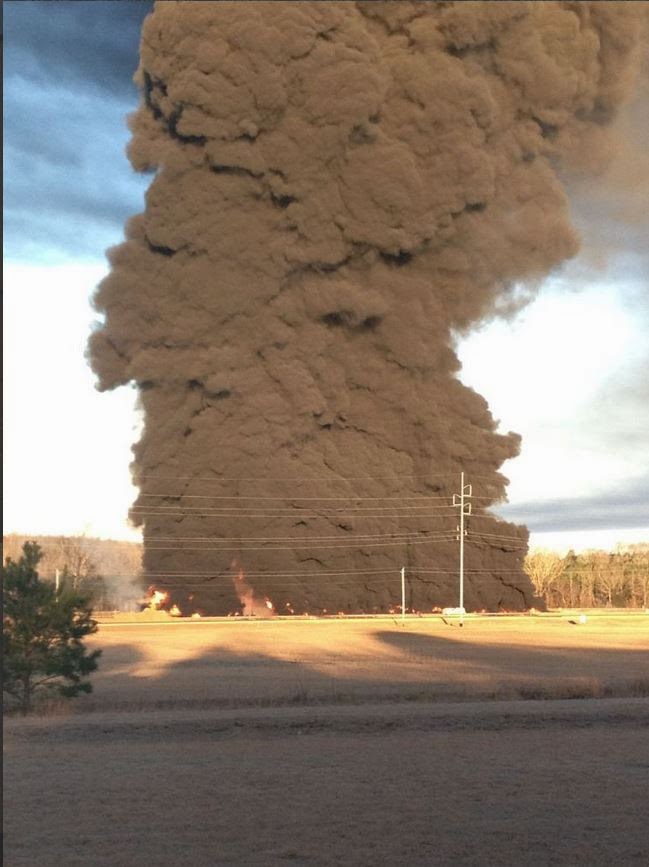NTSB: SYSTEMIC FLAWS IN SAFETY OVERSIGHT OF GAS PIPELINES.
WITH MORE PIPELINES, LNG TERMINALS AND OTHER ENERGY INFRASTRUCTURE COMING CLOSER TO HEAVILY POPULATED AREAS, WE HAVE ALSO BEEN SOUNDING THE ALARM FOR SOME TIME NOW.
WASHINGTON, DC — Several powerful accidents in recent years and in this young year highlight weaknesses in the
oversight of how natural gas providers maintain the largest pipelines in their
networks, accident investigators said Tuesday as they issued more than two
dozen safety recommendations.
A
major effort a decade ago by the federal government to check a rise in violent
pipeline failures in "high-consequence" areas where people are more
likely to be hurt or buildings destroyed has resulted in a slight leveling off
of such incidents, but no decline, the National Transportation Safety Board said.
And
while the frequency of such accidents remains low, they are still more likely
to occur in more densely populated areas despite increased safety efforts in
those areas, the report found.
More
safety improvements are needed "to prevent catastrophic gas transmission
line accidents from ever happening again," said Chris Hart, the acting
NTSB chairman.
A
steady increase in pipeline explosions and fires in the 10 years prior to 2003
prompted the Pipeline and Hazardous Materials Safety Administration to adopt
safety standards in 2004 for inspecting and maintaining the physical integrity
of pipelines, with priority given to high consequence areas.
Since
then, state-regulated pipelines — those that don't cross state borders — have
had a 27 percent higher incident rate than federally regulated pipelines that
traverse more than one state, the report said.
From
2010 to 2013, incidents were overrepresented in high-consequence-area pipelines
compared to less-developed areas where the risk to people and property is less,
the board said.
Three
accidents since 2010 illustrate many of the systemic problems, the board said.
On September 9, 2010, a massive section of pipeline was blown out of the
ground, igniting a giant pillar of fire in San Bruno, a San Francisco suburb.
Nine people were killed and 70 homes destroyed. The blast was so powerful that
residents initially thought there had been an earthquake or jet crash. Because
there were no automatic or remotely controlled valves, more than an hour passed
before the gas could be shut off.
On
Dec. 11, 2012, near Sissonville, W.Va., a stretch of pipeline ruptured,
igniting a fire that destroyed three homes, damaged several others and melted
the asphalt off a nearby stretch of highway. The pipeline hadn't been inspected
in 24 years.
A
similar pipeline ruptured on May 4, 2009, near Palm City, Florida. The blast
tossed 106 feet of buried pipeline into the air. It landed in the right-of-way
between two major highways — Interstate 95 and the Florida Turnpike. Incredibly,
no fire was ignited even though 36 million cubic feet of gas escaped and two
other large gas lines were buried parallel to the one that ruptured. One
policeman was injured. Damage to the pipe's protective coating had gone
undiscovered, and a shut-off valve had failed to close.
In
each of the accidents in the three states, the gas companies failed to conduct
inspections or tests that might have revealed weaknesses in the massive
pipelines, the NTSB found in a report that also reflected federal safety data
and interviews with state inspectors and industry officials.
The
concern then and now is that aging pipelines will rupture in populated areas.
The U.S. is crisscrossed by nearly 300,000 miles of gas transmission pipelines,
more than half of which were installed before 1970. The pre-1970 pipelines have
a significantly higher failure rate because they have been exposed to
environmental forces longer and newer pipelines have been made with improved
safety technology, the board said.
There
is wide variation in states' approaches to pipeline safety oversight in
high-consequence areas, and there isn't enough federal-to-state and
state-to-state coordination between inspectors, the board said.
The
board issued 28 recommendations as the result of the report, most of them to
federal regulators. They urged states to adopt more costly pipeline inspection
methods that are more likely to find problems. They also urged federal
inspectors to work more closely with state inspectors and establish a mentoring
program for them. The board found that state inspectors often lack the
expertise in some areas necessary to safety oversight.
The
board also urged improvements to a national pipeline mapping system so that
states and operators could better determine which areas should be designated
high consequence and therefore given more attention.





